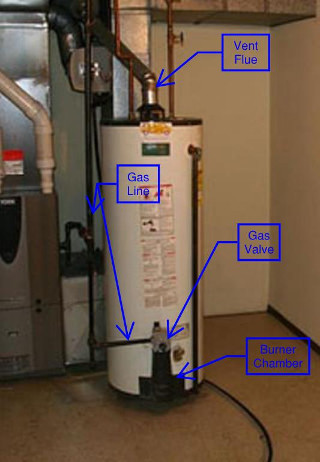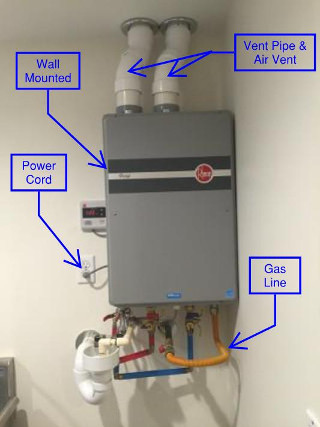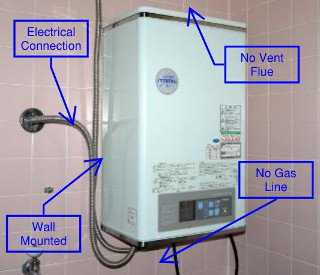Do you know what type of hot water heater that have? Or are you considering a new hot water heater and you want to compare the different types? Either way this article provides valuable information that helps you to identify and compare the various types of hot water heaters that are available on the market.
Do you have a water heater that is not working properly? See the articles 'Troubleshooting Gas Hot Water Heater Problems' or 'Troubleshooting Electric Hot Water Heater Problems' for information on how to solve your problem. Not sure what type of water heater that you have, no problem, review the information below before you proceed.
Electric Hot Water Heaters
Standard Electric Hot Water Heaters
 A standard electric hot water heater has some of the same characteristics that all water heaters have. However, they are simpler than their gas fired cousins, so they have fewer distinctive features. So do identify one, you are looking more for what they don't have instead of what the do have. See the descriptions for Gas Water Heaters below for some of the distinctive gas water heater features. Look for these features to see if your water heater is electric.
A standard electric hot water heater has some of the same characteristics that all water heaters have. However, they are simpler than their gas fired cousins, so they have fewer distinctive features. So do identify one, you are looking more for what they don't have instead of what the do have. See the descriptions for Gas Water Heaters below for some of the distinctive gas water heater features. Look for these features to see if your water heater is electric.
Electrical Hook Up - This is generally a conduit, usually flexible that is attached to the top of the water heater. It is not a regular cord that plugs into an outlet. Most water heaters run on a 50 amp 220/240 volt circuit, so the wiring is heavy duty.
Access Panels - Electric water heaters use 'heating elements' to heat the water. These have electrical terminals that attached to the element that extends inside of the tank. Most water heaters will have two elements. On the side of the water heater you will find two access panels that are attached with screws.
No Gas Line or Gas Valve - Unlike a gas water heater, the electrical supply line is all that is needed. So you won't find a gas line attached to the unit.
No Vent Flue - Electric water heaters do not have any exhaust, so there is no need for a vent flue, plastic or metal.
High Efficiency Electric Hot Water Heaters
High efficiency electric hot water heaters use technology that is similar to a heat pump. As a result, the unit will have a heat exchanger on top of the unit that acts much the same way the heat exchanger works for a heat pump. These units are generally called hybrids in that they use both heating elements and the heat exchanger. Look for some of these features:
- Electrical Supply Line - A heavy duty electrical supply line will be attached to the unit.
- Access Panels - Access panels for the heating elements will be present.
- Heat Exchanger - The heat exchanger is a separate component, but it may appear to be built right into the unit. The heat exchanger will be on top of the water heater and have a blower fan built in.
Tank-less or Inline Electric Hot Water Heaters
Tank-less electric water heaters are much smaller than a standard model. They are normally mounted on the wall and have a clean simple look. You will notice a few things when you see one:
- Electrical Hook Up - Tank-less electric water heaters have a conduit or flexible electrical connection. This is not a cord, instead it is similar to the connection on a range or other heavy duty electrical appliance.
- No Vent Flue - Electric water heaters of this type do not require a vent flue, since no exhaust is generated.
- Wall Mounted - Due to the small size, this type of unit is normally mounted on the wall.
Gas Hot Water Heaters
Standard Gas Hot Water Heaters
 A standard gas hot water heater is fairly easy to identify. It has a few tell tale features that distinguish it from other type. See the following list for the unique features:
A standard gas hot water heater is fairly easy to identify. It has a few tell tale features that distinguish it from other type. See the following list for the unique features:
- Vent Flue - At the top of the water heater there will be a hood that is attached to a 3" or 4" round flue pipe. Standard gas water heaters have 'Hot' exhaust that must be vented into a chimney.
- Gas Line - A gas supply line runs to the unit that usually has a shut off valve in it. This line attaches to the unit near the bottom at the 'Gas Valve'. Normally this line will be a 'black' metal pipe, but it can be other materials.
- Gas Valve - The gas valve is a distinctive looking mechanism that regulates the flow of gas and allows for the lighting of a pilot light. This valve is located near the bottom of the water heater.
- Burner Chamber - A gas water heater has an area at the bottom of the unit where the gas is burned and the water tank is heated. There is usually a small view window or a removable cover that allows for inspection of either the pilot light or the burner itself. If the unit is working properly, a flame or the pilot light should be visible.
- Non Electrical - A standard gas water heater does not require any electricity to operate. So there is no cord or electrical connection.
Power Vent Gas Hot Water Heaters
Power Vent gas water heaters are very similar to standard gas water heaters. The main difference is that it has a fan housing on the top of the unit that forces the exhaust out of a non-vertical vent pipe. These units are used when a standard vertical chimney is not available. Look for these features on a power vent water heater:
- Vent Flue - May be horizontal or a long distance to a vertical chimney.
- Gas Line - Same as a standard gas water heater.
- Gas Valve - Same as a 'standard' gas water heater.
- Burner Chamber - Same a s 'standard' gas water heater.
- Electrical Hookup - A power vent water heater uses a 115 volt power cord to operate. It would normally plug into a standard outlet, although this should be hooked up to a dedicated circuit.
High Efficiency Gas Hot Water Heaters
'High' efficiency gas water heaters may look quite similar to a 'standard' gas water heater. This is due to the fact that they have all of the same equipment requirements, with the possible exception of the type of flue. Unfortunately, the term 'High' can be applied to any water heater that is felt to be a higher efficiency than a standard version. So, the only difference might be additional insulation around the tank.
A true or optimal 'high efficiency' gas hot water heater will have a secondary heat exchanger that extracts additional btu's from the hot exhaust that a gas water heater normally produces. When this technology is employed, the exhaust is cool and the vent can be plastic pipe that can either go horizontally or vertically.
Look for these features on a High Efficiency gas water heater:
- Vent Flue - The vent could be metal or plastic and run either vertically or horizontally or a combination of both.
- Gas Line - This type of water heater will definitely have a gas line running to the unit.
- Gas Valve - This type of unit will also have a gas valve, although it may be hidden in additional protective shrouds.
- Burner Chamber - This type of unit will have a burner chamber, however it may not be as accessible as a standard unit.
- Electrical Hookup - Depending on the level of efficiency, this type of unit can have an electrical hook up. Very high efficiency units need to run impellers to keep the exhaust fumes and/or make up air moving, so electricity is required.
Tank-less or Semi Tank-less Gas Hot Water Heaters
 Tank-less or semi tank-less gas hot water heaters have a very different look than a standard or even a high efficiency gas water heater. First of all, they are a lot smaller and usually mounted on a wall. The reason for this is that the 'tank' that holds the hot water is the biggest feature of a standard water heater. Even if you have a semi tank-less unit, the tank is only a few gallons compared to 40-100 gallons for a conventional unit.
Tank-less or semi tank-less gas hot water heaters have a very different look than a standard or even a high efficiency gas water heater. First of all, they are a lot smaller and usually mounted on a wall. The reason for this is that the 'tank' that holds the hot water is the biggest feature of a standard water heater. Even if you have a semi tank-less unit, the tank is only a few gallons compared to 40-100 gallons for a conventional unit.
So a tank-less, or semi tank-less gas hot water heater will have the following features:
- Vent Flue - This style of water heater will have a vent. Most of the time it will be a plastic pipe that will run either vertically or horizontally or a combination of both. It may have an additional plastic line that supplies air for combustion.
- Gas Line - A gas line is required for this type of unit. Depending on the GPM (gallons per minute) of output, it may have a larger gas line.
- Gas Valve - This unit will have a gas valve, however, it is not generally visible on the outside of the unit.
- Burner Chamber - This unit will have a burner chamber, but it is generally only visible through a small view window on the front of the unit.
- Electrical Hookup - A Tank-less water heater will require electrical power. This is usually, a 115 volt standard outlet. Most units come with a cord attached.
- Wall Mounted -Since the units are small and don't weigh a lot, they are often mounted on a wall. There are several connections that need to be made at the bottom of the unit, so having them up off the ground makes sense.
There are lots of manufacturers out there with several styles for each type of water heater. So, it is impossible to list every identifying feature of every available unit. We hope that this quick list of descriptions will help you if you are unsure about what type of unit you have.


